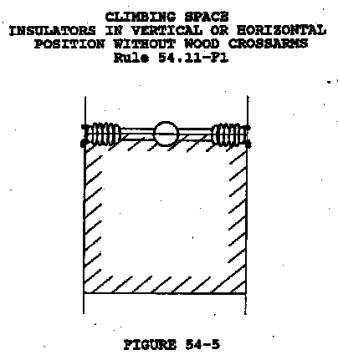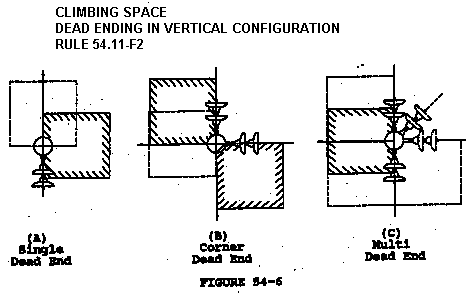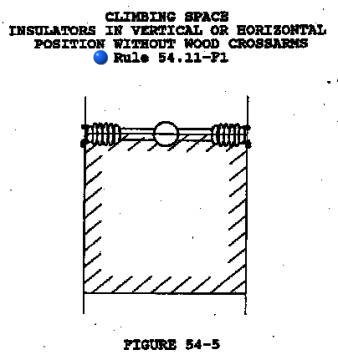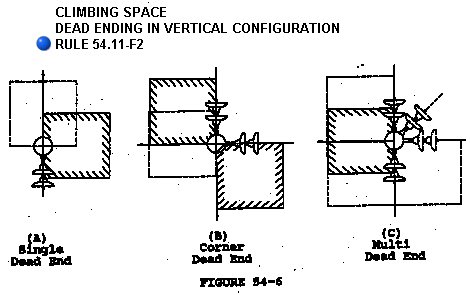
Original Version
Rule 54.11-F
54.11-F. Climbing Space
(1) One Vertical Circuit at Pole Top: For a single circuit at the top of the pole, the climbing space shall be maintained to the lowest conductor on the climbing side of the pole and workmen shall not go above the lowest conductor level,
EXCEPT:
a) When Conductors Are Moved Out From Pole by accepted "hotline" techniques, or
b) When the Pole Top Circuit Is De-energized and grounded, the climbing space shall be maintained to the top conductor of the circuit and the climbing space shall not be less than 30 inches square.
(2) Two Vertical Circuits at Pole Top: When two vertical circuits are installed at the top of pole, the climbing space shall be maintained to the lowest conductor level of those circuits on the climbing side of the pole and workmen shall not go above such lowest conductor level,
EXCEPT:
a) When Conductors Are Moved Out From Pole by accepted "hotline" techniques, or
b) When Both Circuits Are De-energized and grounded the climbing space shall be maintained to the top conductors of the circuits. The space shall not be less than 30 inches square.
c) When One Circuit Is De-energized and grounded, the climbing space shall be maintained on the climbing side between the center line of the pole and the de-energized conductors. The space shall be not less than 36 inches square.
(3) Vertical Circuits Bonded Together: When vertical circuits are bonded together, regardless of location on the pole, the climbing space shall be maintained to the lowest conductor level of those circuits on the climbing side of the pole and workmen shall not go above such lowest conductor level, unless conductors are moved out from pole by accepted "hotline" techniques, or
EXCEPT:
a) Where a Single Circuit is Involved and such circuit is de-energized and the bond and the de-energized circuit is grounded as required in Rule 53.4-A3b, the climbing space shall not be less than 36 inches and shall be maintained for a vertical distance of not less than 4 feet below the lowest conductor and not less than 4 feet above the top conductor when not at the top of pole.
b) Where Two Circuits Are Involved:
1) When Both Circuits Are De-energized and commonly bonded and the bond and the circuits grounded as required in Rule 53.4-A3b, the climbing space shall be maintained to the top conductors of the circuits. The space shall not be less than 36 inches square and shall be maintained for a vertical distance of not less than 4 feet below the lowest conductor and not less than 4 feet above the top conductor when not at the top of pole.
2) When One Circuit Is De-energized and both circuits are commonly bonded and the bond and the de-energized circuit grounded as required in Rule 53.4-A3b, the climbing space shall be maintained on the climbing side between the center line of the pole and the de-energized conductors. The space shall not be less than 36 inches square, and shall be maintained for a vertical distance of not less than 4 feet below the lowest conductor and not less than 4 feet above the top conductor when not at the top of pole.
(4)
Unbonded Circuits Below Pole Top: For unbonded circuits below
the pole top position climbing space shall be maintained through the levels of
conductors supported on post insulators for a vertical distance of not less
than four feet above the top conductor and not less than four feet below the
lowest conductor.
The
climbing space shall be a square of horizontal dimensions tabulated below and
one side of the climbing space shall pass through the center line of the pole.
Voltage of Conductor |
Dimensions of Square |
750-7,500 volts |
36" |
7,500-46,000 volts |
42" |
More than 46,000 volts |
42" plus ½ " per kV in excess of 46 kV |
Strikeout and Underline Version
Rule 54.11-F
54.11-F. Climbing Space
(1)
One Vertical Circuit at Pole Top: For a single circuit at the
top of the pole, the climbing space shall be maintained to the lowest conductor
on the climbing side of the pole and workmen shall not go above the lowest
conductor level, Where
Insulators Are in vertical or Horizontal Climbing Position, more than 750
volts: Climbing space shall be maintained
through the levels of conductors for a vertical distance of not less than 4 feet above the top conductor and not less than 4 feet
below the lowest conductor.
Exception: For a circuit at the top of the pole, the climbing
space shall be maintained to the lowest conductor of the circuit on the
climbing side of the pole (See Figure 54- 5.).
The climbing space shall be a square of horizontal dimensions
tabulated below and one side of the climbing space shall pass through the
center line of the pole.
Voltage of Conductor |
Dimensions of Square |
750-46,000 volts |
36" |
46,000-75,000 volts |
48" |
More than 75,000 volts |
48" plus ½ " per kV in excess of 75 kV |

EXCEPT:
a) When Conductors Are Moved Out From Pole by accepted
"hotline" techniques, or
b) When the Pole Top Circuit Is De-energized and grounded, the
climbing space shall be maintained to the top conductor of the circuit and the
climbing space shall not be less than 30 inches square.
(2)
Two Vertical Circuits at Pole Top: When two vertical circuits
are installed at the top of pole, the climbing space shall be maintained to the
lowest conductor level of those circuits on the climbing side of the pole and
workmen shall not go above such lowest conductor level, Dimensions
Where Conductors Are Dead-ended In vertical Configuration: Climbing space
through conductors shall be a
square of the horizontal dimensions
tabulated below, and shall be located either on one side or a quadrant of the pole (See Figure 54-6.).
Voltage of Conductor |
Dimensions of Square |
750-7,500 volts |
36" |
7,500-46,000 volts |
42" |
More than 46,000 volts |
42" plus ½ " per kV in excess of 46 kV |

EXCEPT:
a) When Conductors Are Moved Out From Pole by accepted
"hotline" techniques, or
b) When Both Circuits Are De-energized and grounded the climbing
space shall be maintained to the top conductors of the circuits. The space
shall not be less than 30 inches square.
c) When One Circuit Is De-energized and grounded, the climbing
space shall be maintained on the climbing side between the center line of the
pole and the de-energized conductors. The space shall be not less than 36
inches square.
(3)
Vertical Circuits Bonded Together: When vertical circuits are
bonded together, regardless of location on the pole, the climbing space shall
be maintained to the lowest conductor level of those circuits on the climbing
side of the pole and workmen shall not go above such lowest conductor level,
unless conductors are moved out from pole by accepted "hotline"
techniques, or
EXCEPT:
a) Where a Single Circuit is Involved and such circuit is
de-energized and the bond and the de-energized circuit is grounded as required
in Rule 53.4-A3b, the climbing space shall not be less than 36 inches and shall
be maintained for a vertical distance of not less than 4 feet below the lowest
conductor and not less than 4 feet above the top conductor when not at the top
of pole.
b) Where Two Circuits Are Involved:
1)
When Both Circuits Are De-energized and
commonly bonded and the bond and the circuits grounded as required in Rule
53.4-A3b, the climbing space shall be maintained to the top conductors of the
circuits. The space shall not be less than 36 inches square and shall be
maintained for a vertical distance of not less than 4 feet below the lowest
conductor and not less than 4 feet above the top conductor when not at the top
of pole.
2)
When One Circuit Is De-energized and both circuits are
commonly bonded and the bond and the de-energized circuit grounded as required
in Rule 53.4-A3b, the climbing space shall be maintained on the climbing side
between the center line of the pole and the de-energized conductors. The space
shall not be less than 36 inches square, and shall be maintained for a vertical
distance of not less than 4 feet below the lowest conductor and not less than 4
feet above the top conductor when not at the top of pole.
(4)
Unbonded Circuits Below Pole Top: For unbonded circuits below
the pole top position climbing space shall be maintained through the levels of
conductors supported on post insulators for a vertical distance of not less
than four feet above the top conductor and not less than four feet below the
lowest conductor.
The
climbing space shall be a square of horizontal dimensions tabulated below and
one side of the climbing space shall pass through the center line of the pole.
|
|
|
|
|
|
|
|
Final Version
Rule 54.11-F
54.11-F. Climbing Space
(1)
Where
Insulators Are in vertical or Horizontal Climbing Position, more than 750
volts: Climbing space shall be maintained
through the levels of conductors for a vertical distance of not less than 4 feet above the top conductor and not less than 4 feet
below the lowest conductor.
Exception: For a circuit at the top of the pole, the climbing
space shall be maintained to the lowest conductor of the circuit on the
climbing side of the pole (See Figure 54-5.).
The climbing space shall be a square of horizontal dimensions
tabulated below and one side of the climbing space shall pass through the
center line of the pole.
Voltage of Conductor |
Dimensions of Square |
750-46,000 volts |
36" |
46,000-75,000 volts |
48" |
More than 75,000 volts |
48" plus ½ " per kV in excess of 75 kV |

(2) Dimensions Where Conductors Are Dead-ended In vertical Configuration: Climbing space through conductors shall be a square of the horizontal dimensions tabulated below, and shall be located either on one side or a quadrant of the pole (See Figure 54-6.).
Voltage of Conductor |
Dimensions of Square |
750-7,500 volts |
36" |
7,500-46,000 volts |
42" |
More than 46,000 volts |
42" plus ½ " per kV in excess of 46 kV |
